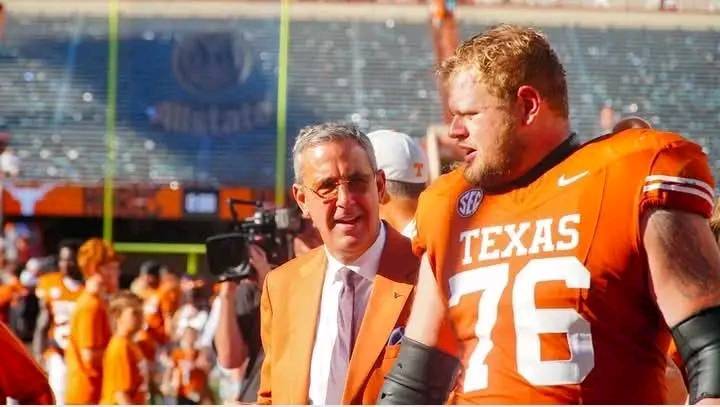BREAKING — Austin, Texas: In what has now become an almost expected tradition of excellence, the University of Texas Longhorns have officially clinched the 2025 Learfield Directors’ Cup, the most prestigious award in collegiate athletics, for an astonishing fourth time. The momentous achievement further solidifies Texas as one of the dominant powerhouses in college sports, not just for its on-field success but for its culture of excellence that transcends sports, uniting student-athletes, coaches, fans, and alumni in a shared legacy of greatness. The Longhorns now stand tall among the elite, once again proving that their commitment to winning is matched only by their standard of sustained excellence across all programs.
The Learfield Directors’ Cup, administered by the National Association of Collegiate Directors of Athletics (NACDA) and USA Today, is awarded annually to the top-performing athletic department in the country. It takes into account NCAA finishes across a wide array of men’s and women’s sports. To win it once is a tremendous feat. To win it four times, including in such a competitive landscape that includes historic bluebloods like Stanford, Michigan, and Florida, is a declaration of dominance. And in 2025, the University of Texas left no doubt. From the football field and basketball court to the pool, the track, the diamond, and beyond, the Longhorns amassed point after point with national finishes that reflected the breadth and depth of their athletics program.
The Longhorns’ fourth Directors’ Cup title didn’t come by accident. It was built on a foundation of discipline, elite recruiting, exceptional coaching, and a never-satisfied mentality that pervades every locker room in Austin. The commitment starts at the top. Texas Athletic Director Chris Del Conte has often said that Texas doesn’t just want to compete—it wants to win in everything. That vision has now been realized once again, with Texas continuing to climb the summit of collegiate success. “This isn’t just about football or basketball,” Del Conte said earlier this year. “This is about building a culture where every athlete has the tools, support, and expectation to be elite.”
That culture was on full display throughout the 2024–25 academic year. Texas racked up national championships in several sports and top-five finishes in many more. The football team, rejuvenated under head coach Steve Sarkisian, returned to the College Football Playoff for the second year in a row, reinforcing Texas’ position as a resurgent powerhouse on the gridiron. Quarterback Arch Manning delivered on his enormous potential, leading an offense that was both explosive and efficient. The Longhorns’ defense, too, was among the nation’s best, thanks to a ferocious pass rush and a secondary filled with future NFL talent.
But while football often commands the headlines, it’s the overall balance and depth of success across Texas’ programs that has elevated the Longhorns to the top of the Learfield Directors’ Cup standings. The women’s volleyball team, led by head coach Jerritt Elliott, once again reached the Final Four and has now established a dynasty that rivals any program in the country. The women’s swimming and diving team claimed yet another national title, showcasing the prowess of Olympic-caliber athletes like Emma Sticklen and Erica Sullivan. The men’s and women’s track and field teams combined for one of their strongest seasons in program history, producing multiple NCAA champions and breaking school records along the way.
The baseball and softball teams also had campaigns to remember. Head coach David Pierce’s baseball squad made a thrilling run to the College World Series, fueled by dominant pitching and clutch hitting. On the softball side, head coach Mike White’s team surged through the NCAA Tournament behind All-American performances and a team-wide commitment to resilience and focus. Both teams not only delivered results but energized a fanbase that has long been one of the most passionate and dedicated in college sports.
Meanwhile, Texas basketball has never been in a better place. The men’s team reached the Elite Eight under the guidance of head coach Rodney Terry, building on strong recruiting classes and tough, physical defense. The women’s basketball team, led by head coach Vic Schaefer, earned a No. 1 seed in the NCAA Tournament and made a Final Four appearance, with Madison Booker emerging as one of the nation’s premier stars. It was a season that reminded the nation that Texas is not just a football school—it’s a national force in every major sport.
Beyond the high-profile sports, Texas excelled in Olympic and non-revenue sports as well. Men’s golf delivered a top-three national finish, men’s tennis won the ITA National Team Indoor Championship, and women’s rowing and soccer both reached the NCAA Tournament’s later rounds. The consistency of success across so many different programs is what defines a Directors’ Cup champion—and in 2025, Texas was simply unmatched.
This fourth Directors’ Cup victory speaks volumes about Texas’ broader athletic infrastructure. The investment in world-class facilities like the Moody Center, the support from a university leadership that believes in championship culture, and the strength of the Longhorn Foundation’s donor base all contribute to an ecosystem where elite athletes can thrive. In today’s ever-evolving college sports landscape—one defined increasingly by NIL, the transfer portal, and conference realignment—Texas has managed to adapt quickly and effectively. Not only has the university maintained its traditional identity, but it has also embraced innovation and change to stay ahead of the curve.
One of the most powerful forces behind Texas’ 2025 triumph was its student-athletes themselves. Time and again this year, Longhorns rose to the occasion, delivered in pressure-packed moments, and showed what it means to wear the burnt orange. From Cooper Flagg’s electrifying performances in basketball to NiJaree Canady’s return to Texas softball via a powerful NIL deal, the athletes have both honored and expanded the Texas legacy. Their achievements have become part of the fabric of the school’s athletic identity—one woven with ambition, tradition, and a refusal to settle for second best.
Texas’ fans also played a significant role throughout the year. Game after game, meet after meet, they showed up in record numbers. From the 100,000-strong at DKR-Texas Memorial Stadium to raucous volleyball and basketball crowds at the Moody Center, the Longhorn faithful proved once again why they are among the most loyal and passionate fanbases in the country. Their support not only motivates athletes but also helps drive the financial engine that keeps Texas competitive in every sport.
Looking forward, the future appears even brighter. With recruiting classes ranked near the top across multiple sports, a coaching staff that continues to innovate and inspire, and the move to the SEC now fully integrated, the Longhorns are poised to remain at the top of the college sports world for years to come. Texas isn’t just winning—it’s building a legacy that could define the next era of NCAA athletics.
To win the Learfield Directors’ Cup once is a historic accomplishment. To win it four times—especially in a stretch of just a few years—is something else entirely. It signals not just greatness but sustained greatness. And that’s what the University of Texas has built. A machine of excellence that spans locker rooms and generations, uniting the burnt orange community under a single banner of championship-caliber pride.
As the sun sets on another remarkable year in Texas athletics, the glow of the Directors’ Cup shines bright in Austin. For the fourth time, the Longhorns have climbed the mountain and planted their flag at the peak of collegiate sports. And in doing so, they’ve reminded the world that in the realm of college athletics, everything really is bigger—and better—in Texas.



